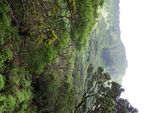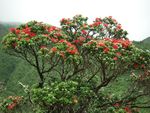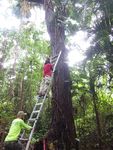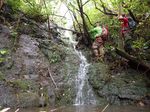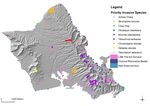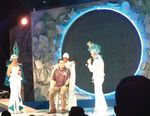2016 Report to the Hawaiʿi Invasive Species Council - The Koʿolau Range with Hawaiʿi's most well-known native trees, koa and ʿōhiʿa, in the ...
←
→
Page content transcription
If your browser does not render page correctly, please read the page content below
2016 Report to the
Hawaiʿi Invasive Species Council
The Koʿolau Range with Hawaiʿi’s most well-known native trees,
koa and ʿōhiʿa, in the foreground.The Oʿahu Invasive Species Committee (OISC) protects Oʿahu’s watersheds, ecosystems and agriculture by preventing harm from invasive species. The OISC field crew conducts surveys and control for invasive species that have not yet become abundant enough to damage the island’s agriculture and ecosystems, but likely would cause harm if not controlled. The OISC field crew is like the vitamin C that a person takes after feeling the first symptoms of a cold. By going after and OISC crewmember happy to have found a miconia removing invasive species before it set seed. before Oʿahu residents begin to feel the effects, we can prevent expensive and costly remediation measures later. OISC operations are guided by the OISC steering committee which is made up of representatives of conservation organizations and land managers. Many of the people who serve on OISC’s steering committee today were giving up their weekends to control invasive species as volunteers when OISC was Terrain encountered during a typical survey for miconia. first formed back in 2001. In 2016, HISC awarded OISC $729,048 for survey and control of priority invasive species and outreach. OISC raised an additional $511,517 from other sources. (Grants received from HISC for control of Tibouchina herbacea at Poamoho are discussed in a separate report). The deliverables and accomplishments described below include HISC-funded activities and leveraged funds.
In 2016, OISC continued steady progress towards stopping the spread of species like miconia (Miconia calvescens), Himalayan blackberry (Rubus discolor), devil weed (Chromolaena odorata), glory bush (Tibouchina urvilleana) and Cape ivy (Delairea odorata). There were zero detections of fireweed (Senecio madagascariensis) at a previously infested site. We also began working with the Division of Forestry and Wildlife on early detection for Rapid ʿŌhiʿa Death (ROD). OISC partnered with the Hawaiʿi Department of Agiruculture to conduct treatments for little fire ant (Wasmannia auropunctata) and coqui frog (Eleutherodactylus coqui) and to continue early detection for naio thrips (Klambothrips myopori) and the coconut rhinoceros beetle (Oryctes rhinoceros) along the Windward coast. OISC also continued to present invasive species information to students, teachers, the landscape industry, recreational groups and others. Miconia (Miconia calvescens) Miconia is a high-priority target for OISC because once established, it may severely degrade Oahu’s watershed. Miconia’s shallow root systems may be unable to hold soil in place during heavy rains and its unusually large leaves funnel rainwater to the ground with tremendous force. These characteristics indicate that a miconia- dominated forest will be more prone to erosion than a nativ- dominated one. Unfortunately, miconia seeds remain viable in the soil for up to 21 years, making this a project that requires long- term financial comittment. Monotypic stands of miconia in Tahiti, note the lack of understory and OISC’s strategy is to survey the exposed roots, a sign of erosion. entire estimated seed bank of Photos: Ryan Smith miconia every two to three years to find and remove trees before they mature. In 2016, OISC conducted miconia surveys in 21 different watersheds across 4,970 acres by ground and 8,548 acres by air totalling 13,518 acres. The crew removed 1,152 immature and 12 mature miconia trees. Of the 1,152 immature trees, 70 were over 2 meters tall. Trees over 2 meters tall are tracked because if they are missed, they are likely to flower and set seed by the time the OISC crew finds them again. OISC’s goal is to keep the number of mature trees to zero. The length of time the seeds can remain viable in the soil has made it difficult to achieve that goal. However, OISC is making progress. In 2002, the first year that OISC had a full 12 months of paid staff, OISC removed 40 mature and 3,347 immature trees across 2,041 acres. Ninety-four of those trees were over 2 meters tall. That averages out to .0196 mature trees per acre in 2002, compared to just .0008 mature trees per acre in 2016, a drop of 96%.
Although the island-wide numbers are good, there were some range extensions in 2016. During an aerial survey in December, the OISC field crew found an immature tree in Waiawa, close to the summit in native forest. This point is approximately 1,800 meters away from the nearest mature tree. OISC conducted an analysis of the distances between mature and immature trees in 2009 and found that while 99% of mature trees fell within 450 meters of a mature tree, 1% fell within 1600 meters. This tree goes even beyond that range and validates that OISC should continue to survey for outlier trees since it would only take one mature tree to begin a new population in a new watershed. OISC conducted 3,164 acres of surveys around the immature miconia tree that (Below) A minimal amount of herbicide is required to prevent was found in ʿAiea watershed last year larger miconia trees from re-sprouting. Smaller trees can be approximately 7,000 meters away from simply pulled from the ground and hung in the surrounding the nearest mature tree and found no vegetation (above rightI). Miconia is so tolerant of shade that additional miconia. The ability of miconia it can grow in conditions too dark for most other species, seeds to remain dormant in the soil for such as this bamboo patch (above left). many years was confirmed this year at Wahiawā Botanical Garden. The Garden removed their mature tree in 1995 but still finds seedlings and reports them to us when they find them. OISC has done numerous surveys around the Garden and never found any trees, so we assume that the seedlings are coming from dormant seeds in the soil produced by the tree removed in 1995. That puts the current seedbank longevity at 21 years. In 2016, OISC worked with Dr. James Leary of UH Mānoa CTAHR to use Herbicide Ballistic Technology (HBT) to control miconia by air in areas too steep to survey effectively and to cover more ground quickly in areas that are heavily infested. HBT allows a user to apply herbicide from a helicopter using a paintball gun apparatus. It is more efficient and safer in steep areas than other methods.
Deliverable Deliverable met?
Survey 2,400 acres by ground and 2,200 by air for Yes: OISC surveyed 4,970 acres by ground and
Miconia calvescens and control all plants found. 8,548 acres by air for miconia. Of these surveys
3,164 were dual surveys for both miconia and
devil weed (Chromolaena odorata). Although
there was a range extension into a new
watershed, islandwide the number of mature
trees is still lower than when miconia surveys
started in 2002.
Miconia: Mature and > 2 meters 2002-2016
160
140
120
100
80
60
40
20
0
2002 2003 2004 2005 2006 2007 2008 2009 2010 2011 2012 2013 2014 2015 2016
Mature >2m Surveyed Acres (in hundredths of acres)
Mature trees are a subset of >2 meters; Heights are estimates.
Devil weed (Chromolaena odorata)
The common name of Chromolaena odorata is “devil weed” and for good reason. It is toxic to livestock
and humans and a weed of conservation and agricultural concern throughout Africa and the Pacific.
Populations of this species are currently known to occur at the Kahuku Training Area, in ʿAhupuaʿa ʿO
Kahana State Park and in ʿAiea. No new populations were found in 2016, although an individual
immature plant was found growing out of a naupaka (Scaevola sericea) along a public beach access in
Lanikai. OISC conducted road surveys in the surrounding area and found no plants. OISC surveyed both
Joint Base Pearl Harbor and the Marine Corps Base Hawaiʿi since a large part of the ʿAiea infestation
occurs at Camp Smith and with vehicle traffic and landscaping equipment possibly moving between the
two sites, it seemed like a good to survey those areas. No plants were found.
OISC also responded to a public report of devil weed in Waiawa Valley, but no devil weed was found. A
common plant that looks very similar devil weed was found in the location described in the report. Devilweed likes disturbance and it can grow along roadsides, so road surveys are an efficient way to monitor
for this species. OISC conducted 1,491 acres (10 acres for each mile of road) of road surveys in 2016 in
neighborhoods adjacent to naturalized populations. OISC also continued survey and control work at KTA
and in ʿAiea. In total OISC surveyed 5,690 acres for devil weed. OISC borrowed a customized spray rig
from the Oʿahu Army Natural Resources Program (OANRP) to spray the population in Kahana Valley.
Treating the entire area by air took only a day and was much more efficient than had the sprays been
done by personnel on the ground. We are grateful to the cooperation of the State of Hawaiʿi Division of
State Parks for their cooperation.
Deliverable Deliverable met?
Delimit in ʿAiea Valley Yes: OISC surveyed 1,397 acres by air and 975
acres by ground. Some of these surveys were
dual surveys with Miconia calvescens.
Verify and map reports from the public. Yes: OISC surveyed Waiawa Valley in response
to a public report and determined the person
reporting had seen a common species that looks
very similar to devil weed. OISC also verified the
report from the beach access path in Lanikai
from a photo (the person reporting pulled the
plant) and conducted surveys to find additional
plants.
Control where feasible Yes: OISC conducted control work at Kahuku
Training Area, in Kahana Valley and in ʿAiea.
Treated areas have responded to the treatment
with very little re-growth.
Investigate efficacy of biocontrol if needed. Yes: Discussed biocontrol with Hawaiʿi
Department of Agriculture and reviewed
literature on use of previously developed
biocontrols in other countries where devil weed
is a problem. Assisted a partner agency to write
a proposal that would have funded testing on
native Hawaiian plants.
Rapid ʿŌhiʿa Death: (Ceratocystis spp.)
Rapid ʿŌhiʿa Death (ROD) is a forest disease caused by the fungal pathogen Ceratocystis. The pathogen
has killed ʿōhiʿa trees across at least 30,000 acres on Hawaiʿi Island. In 2016, OISC performed early
detection aerial surveys over aproximately 85,638 acres of Oʿahu‘s ʿōhiʿa forest. The surveys were flown
higher and faster than what is standard when looking for individual plants such as miconia. Despite this,
the crew was still able to see individual ʿōhiʿa trees that had died. OISC used software called Digital
Mobile Sketch Mapping developed by the US Forest Service to record point locations and attach those
points to photos. The work on Oʿahu is part of a statewide effort that is conducting early detection using
the same methodology on all islands and is done in close cooperation with DLNR/DOFAW.An ʿōhiʿa in full bloom in the Koʿolau Range, Oʿahu.
The crew did find trees that should be sampled for Ceratocystis, but getting to them has been
problematic. They were either located in terrain that was too steep, or on private land. OISC is working
on figuring out access points and aquiring permission for these points so they can be sampled.
As a result of the statewide outreach surrounding this disease, OISC received several reports of dead
ornamental ʿōhiʿa. OISC responded to these reports and has submitted 8 samples from seven different
watersheds. All the samples submitted tested negative for Ceratocystis.
Deliverable Deliverable met?
Survey all ʿōhiʿa forest. Partially: OISC was able to survey all ʿōhiʿa forest
for signs of ROD except the windward side of
the Koʿolau Range. This area will be the focus of
surveys in 2017.
Cape Ivy (Delairea odorata)
Cape ivy invades dry forests on the Big Island and can smother native plants. The OISC crew has been
monitoring and controlling a Cape ivy infestation in Pālehua. Through persistent treatment, the
infestation has been drastically reduced from patches that were too numerous to count to just 1 mature
and 1,365 individual immature plants. This has freed up time to begin further delimitation surveys an
additional 100 meters from known infestation sites. During one of these surveys the crew did find one
additional patch. It has since been controlled. In total, OISC has done repeated surveys for 400 acres
around the location where this species was introduced so we are optimistic that our efforts we will beable to keep the Waiʿanae Range free of this species. There is only one other location of this species on
the island, in Makiki. Unfortunately the landowner at this location will not allow us to conduct control
work.
Deliverable Deliverable met?
Monitor efficacy of control over 15-acre Yes: OISC was able to visit the area twice and
infestation. conduct additional delimiting surveys for a total
of 293 acres.
Fireweed (Senecio madagascariensis)
Fireweed is toxic to livestock and established on Maui and Hawaiʿi Island. It has made its way to Oʻahu
several times now and OISC and its partners have been able to eradicate it each time. In 2016, OISC
lowered its survey frequency since none had been found at the infestation site in 2015. No plants were
found again in 2016 after 216 acres of ground surveys and 211 acres of road surveys.
Deliverable Deliverable met?
Survey and control at Kawailoa Yes: OISC conducted 227 acres of surveys and
none was found.
Himalayan blackberry (Rubus discolor)
Himalayan blackberry is a thorny vine that is a serious
problem in the Pacific Northwest. OISC staff have been
told that it was planted on public land by a resident of
Pālolo for fruits and to dissuade trespassers. It spread up
the valley to the point where the forest becomes more
dominated by native plants than invasives. This species is
difficult to control since it is resistant to available
herbicides and re-grows easily from cut stems and roots.
Despite these challenges, OISC has drastically reduced
Himalayan blackberry numbers. There are two subunits
within the Palolo watershed that OISC surveys. In the
Waiʿōmaʿo subuit, OISC has reduced Himalayan blackberry
from 1,722 plants in 2008 to only 16 plants in 2016. Along
Mauʿumae Ridge, OISC has reduced the number from
1,002 plants to 32. A mature plant has not been seen at
either site since 2011. Small Himalayan blackberry plant.
Deliverable Deliverable met?
Survey 32 acres for Himalayan blackberry (Rubus Yes: OISC surveyed 62 acres and treated 48
discolor) infestation and control all plants found. immature plants. A mature plant has not been
seen since 2011.
Pampas grass (Cortaderia spp.)
OISC did not survey for pampas grass this year in order to make room to work on other species. The last
plant seen in Kīpapa valley was in 2008 and the area has been subsequently surveyed 5 times. In Haʿīku
Valley, there was one plant treated in 2013, and the site was surveyed by air in 2015 with no plants
found. OISC discussed seedbank longevity with an expert on Cortaderia selloana, Dr. Joseph DiTomasoof the University of California at Davis. Dr. DiTomaso said that he had done seed bank trials of
Cortaderia selloana and the seeds could germinate only up to six months. He had not conducted trials
on Cortaderia jubata, but he suspected it was about the same. Therefore, OISC feels confident that the
plant in Kīpapa valley is a successful localized eradication. OISC will check the Haʿīku plant point again in
2017 and if nothing is found we will categorize that as a local eradication.
Deliverable Deliverable met?
Check on historical points in naturalized areas of No: OISC decided to postpone monitoring
Haʿiku and Kīpapa. surveys in order to make room for other surveys
that were more urgent.
Verify new reports and remove with cooperation NA: None reported.
from landowner.
Fountain grass (Cenchrus setaceum)
Fountain grass is an OISC target because it is highly adaptable to fire and outcompetes native plants by
altering the fire regimes of native forests. It is established at Diamond Head and Lanikai on Oʿahu, but
OISC’s goal is to keep it from establishing in the Waiʿanae Range. In 2016, OISC surveyed over 1,069
acres by air (356 acres) ground (69 acres) and road (640 acres). Unfortunately the landowner where this
species occurs will not allow us to use herbicide and there is more of this species than can be effectively
managed with handpulling at this time. An additional population has been seen and mapped by an OISC
partner and the species does appear to be creeping up the ridge that separates Mākua Valley from
Keaʿau Valley.
Deliverable Deliverable met?
Continue surveys and control over 10 acres in Yes: OISC surveyed over 1,069 acres by air (356
Ohikilolo Valley. acres) ground (69 acres) and road (640 acres) .
Continue to monitor and treat isolated Yes, pulled 48 plants by hand.
populations in Waiʿanae Valley.
Glory bush (Tibouchina urvilleana)
Glory bush is a striking ornamental plant that outcompetes natives in wet forest environments. In places
on Hawaiʿi Island where it is naturalized, glory bush makes its way into 30-foot high ʿōhiʿa canopy . Oʿahu
residents have cooperated when OISC has asked them to remove landscape plantings of glory bush, and
one naturalized population was treated in the Tantalus area. The species grows well vegetatively but the
population is near to eradication. In 2016, no plants were seen in the previously infested site.
Deliverable Deliverable met?
Control all plants. Yes: OISC monitored 7.6 acres of previously
infested sites and found no plants.
Coqui frog (Eleutherodactylus coqui)
OISC provides systematic monitoring support to the Hawaiʿi Departement of Agriculture (HDOA) for
early detection of coqui frogs. Coqui frogs can be stowaways on plants and other items such as vehicles,
boats and construction materials from areas on Hawaiʿi Island with large coqui frog populations. OISC
assists with responding to reports from the public, treatments and monitoring areas to ensure
treatments were effective. In 2016, OISC conducted 28 surveys over six separate sites. OISC staff
captured 57 frogs and conducted three separate treatment operations to control frogs at sites withlarger populations. HDOA staff has conducted separate surveys and captures, so this number does not
represent the total number of coqui frogs caught on Oʿahu in 2016.
Deliverable Deliverable met?
Assist HDOA with responding to coqui reports Yes: OISC conducted 28 surveys at three
from the public. Survey 6 high risk sites on a separate sites. Two sites were nurseries, one
quarterly basis. was a response to a public report at a private
residence. 57 frogs were captured in total. OISC
forwarded reports from the public to HDOA, but
they only requested assistance with the one
mentioned above. OISC assisted with three
treatment operations at two different sites.
Little Fire Ant (LFA) (Wasmannia
auropunctata)
LFA is a tiny stinging ant that is established
on Hawaiʿi Island and was accidentally
introduced to Oʿahu in two separate
locations. In 2016, OISC assisted HDOA and
the Hawaiʿi Ant Lab with surveys, treatment
and outreach. OISC maintained trails in
advance of treatment and monitoring
surveys in Waimānalo and assited with
monitoring surveys in Mililani. OISC
conducted early detection surveys at 78
separate sites that included retail nurseries,
8 community gardens, three responses to
reports from the public and 7 high-risk sites
at Joint Base Pearl Harbor Hickam. OISC also
surveyed 2,722 meters of Waimānalo
stream which runs through places where
LFA has previously been found. In 2016,
little fire ant was found at three nurseries
where it was subsequently treated.
(Right) OISC and the Hawaiʿi Ant Lab
working to treat the last remaining little
fire ants in a tree in Waimānalo.Deliverable Deliverable met?
Coordinate with the Little Fire Ant Oʻahu Incident Command Partially: OISC was only assigned 78
System to prioritize the survey of 170 high risk sites. Survey unique sites in addition to the stream
150 of these site, treat as needed and assist with mapping. survey. OISC conducted 96 surveys
including a stream that spanned 52
seprate properties for a total of 148
sites (18 sites included repeat visits).
OISC also responded to public reports
and assisted with treatment and
mapping.
Myoporum thrips (Klambothrips myopori)
Myoporum thrips have been damaging and killing Hawaiʿi’s native naio trees (Myoporum sandwicense)
on Hawaiʿi Island since they were discovered in 2009. Naio figures prominently in coastal restoration
projects and is a popular ornamental for those wishing to landscape with native plants. OISC has been
checking naio plants on Oʿahu continuously since 2011 as an early detection strategy for the thrips. In
2016, OISC surveyed 72 locations with naio plants. No thrips were found.
Deliverable Deliverable met?
Conduct 24 early detection surveys for Yes: OISC conducted 72 early detection surveys, all were
Myoporum thrips at high risk sites. negative.
Coconut Rhinoceros Beetle (Oryctes rhinoceros)
Coconut rhinoceros beetle (CRB) is currently limited to Oʿahu and a separate CRB response team is
taking the lead in the response. OISC assists where necessary. CRB damage can kill coconut and other
palms.
Deliverable Deliverable met?
Assist CRB Response Team with Yes: OISC checks and maintains 80 traps along Oʻahu’s
monitoring of traps across the windward coast and sends data to the CRB response team. No
island. CRB was found in OISC maintained traps during 2016.
Identification and Risk Assessment:
OISC had previously been able to identify plant species for the public, however the person that was
doing this left for another position. OISC has the capacity to identify plants right now, but we have not
received any inquiries. OISC has established a relationship with the University of Hawaiʿi Joseph F. Rock
Herbarium to voucher specimens.
Deliverable Deliverable met?
Identify 150 specimens submitted by the general No: Only 15 specimens were submitted by the
public. public. These were identified. Another 48
specimens were submitted by other natural
resource professionals. These were also
identified for a total of 63 specimens.Other Activities and Deliverables:
Deliverable met?
Deliverable
Respond to new species as appropriate and in Yes: OISC is working with the Rapid ʿŌhiʿa Death
consultation with OISC Steering Committee. response team to conduct early detection and
be ready for action if a sample tests positive.
Store the data from daily field activities in a Yes: OISC submitted all required reports and
relational and geographic database and report as worked with HISC on a new reporting format.
part of the annual HISC report to the legislature.
Participate in statewide policy coordination throgh Yes: OISC staff participated in statewide data
CGAPS meetings and other forums. meetings, the Rapid ʿŌhiʿa Death Symposium
and monthly conference calls, CGAPS meetings
and submitted comments to the statewide
biosecurity plan.
Species Treated in 2016Outreach:
OISC recognizes that outreach is
integral to invasive species
management. OISC needs public
support so that we can gain access
to the private property we need to
survey so that our eradication
efforts are truly island-wide. For
species like coqui frog and little fire
ant, that can be transported
anywhere on the island, we need
the public to be our eyes and ears.
We also want the public to know
what they can do to help our
efforts. For example, buying non-
invasive plants and washing gear
and equipment (especially boots)
goes a long way towards preventing (Above) OISC field crewmember receiving a “Water Heroes” cape
invasive species introductions. during the Hawaiʿi Theatre for Youth Production “H2O, the Story of
Water and Hawaiʿi. (Below) A poster about little fire ants made by
students after an OISC school visit
The outreach program has
conducted 21 presentations this
year, reaching 470 people. These
included the civil engineering firm
AECOM’s All-Hands meeting of 100
people, O‘ahu Pig Hunters
Association, Hawai‘i Association for
Environmental Professionals, the
Kāneʿohe Rotary Club, the
Afterschool Alliance Conference and
the Hawai‘i Environmental
Education Alliance Symposium. OISC
provided invasive species updates at
eight Mānoa Neighborhood Board
meetings, directly reaching 226
community members. Hawai‘i
Landscape magazine printed a little
fire ant (LFA) authored by OISC in their fall issue and OISC met with eight legislators in March to provide
updates and information about Rapid ʿŌhiʿa Death. OISC presented and trained teachers on how to use
LFA surveys as an activity for science classes. The remainder invasive species presentations were given
to various community groups around the island. Presenting to community groups has proved to be a
valuable way to reach audiences that can be innovators and early adopters of invasive species
prevention. These are the sectors of the community with which new partnerships can be forged and key
community stakeholders are often found.OISC participated in 34 events this year including the Hawaii State Farm Fair, Ocean Fest, The Hawai‘i Pet Expo, Hawaiʿi Tattoo Expo, and CTAHR’s Oʿahu Ag and Environmental Awareness Day, which had the largest audience of 420 middle school children. OISC field crew members were honored as Water Heroes at the Honolulu Theater for Youth’s musical, “H2O: The Story of Water and Hawai‘i”. Little Fire Ant Classroom Activity (1,831) and School Visits (442) The number of students taught the LFA classroom activity has increased 3.5 times over last year’s total of 460. The LFA classroom activity uses current curriculum standards to teach students about invasive species and LFA and supplies testing kits so that students can test their yards and identify the ants they find. This year OISC visited 13 different schools and reached 1,600 students with the LFA activity, yielding 788 ant samples. OISC also presented the LFA activity to 231 teachers and students who then implemented the activity independently with their projects or in their classrooms. In addition to little fire ant specific messaging, OISC has visited a total of 12 schools reaching 442 students with messaging about invasive species impacts and conservation careers. Materials (7,002,065) Website (9,624) and Social Media (6,431) OISC distributed informational products about OISC target species to legislators, partners, businesses, and community associations. We also created an Adwall for LFA to be installed on every bus on Oʿahu for the Spot the Ant, Stop the Ant Month in October. The Adwall averages 7 million views each month. We have also made and distributed over 2,265 LFA kits to students and the general public. We have been keeping our website up-to-date with information, not only about OISC targets, but also with emerging threats from ROD. We have had 9,624 people visit our website and viewing our website 26,820 times. We also have been increasing our presence on social media with Facebook, Instagram and Twitter posts. OISC’s Facebook, Instagram, twitter, YouTube, Vimeo, and volunteer blog messages were served to 100,940 people (meaning they received it in their feed) and 6,431 people engaged our messages (meaning they clicked, liked, or shared the post). Volunteers (396 hours) OISC leads monthly volunteer invasive species surveys in partnership with Lyon Arboretum. In 2016, volunteers dedicated 395.75 hours to survey 83 acres and remove 1,383 invasive plants. (328 Ardisia virens and 1047 Stromanthe tonckat). This year, there was a 69% drop in plants per acre from 2015, and in the past three years, there has been an 80% drop in plants. There was a drop in volunteer hours this year by 41 hours, however there was a noticeable about of “no-shows” in October and November. To compensate, the cut-off to close the RSVP form will be 16 people instead of the previous 12 people. Despite the drop in volunteer hours, the trips in 2016 yielded the highest amount of acres surveyed since the program began. Volunteers surveyed 83 acres this year, compared to 68 acres last year. This increase can be attributed to having so many repeat volunteers that are familiar with the plants and the terrain. Three volunteers have come to at least 70% of our trips. One of the newly regular volunteers began volunteering after OISC’s presentation to the Kāneʿohe Rotary Club meeting in July. This volunteer is also a librarian at UH Mānoa Life Sciences and put together an LFA display for the library. Another volunteer is working with the NARS invertebrate program to raise Kamehameha butterflys. Another is clearing the false ʿawa (Piper auritum) from their property. False ʿawa is an invasive species that is too widely distributed for OISC to take on. One of the best “extras” with volunteer trips are seeing new friendships formed between the volunteers and hearing the little things people implement into their lives to help with invasive species management on O‘ahu.
The table below describes how OISC’s outreach deliverables were met:
Deliverable Deliverable met?
100 landowners engaged in invasive species control. Yes: 198 properties were contacted for
access. 167 property owners agreed to let
OISC field crew survey their property for
invasive species.
300 volunteer hours and eight volunteer trips. Yes: Volunteers donated 396 hours to
invasive species control in 2016.
40 presentations or participation in events at schools, Yes: OISC did a total of 55 presentations
community groups, neighborhood boards and other and events reaching a total of 4,352
organizations. people.
500 posts to OISC’s social media sites. Almost: OISC made 358 posts to its social
media sites.
Assist with the development and implementation of a Yes: OISC outreach staff worked with HISC
statewide public outreach event for Hawaiʿi Invasive to sponsor a video contest for high-school
Species Awareness Week 2016. students.
Update OISC’s website with information regarding Yes: Facebook and Instragram were
target pest and general invasive species information updated regularly with a reach of 100,940
and assist in updating the HISC’s website species page. and engagement of 6,431.
3 presentations or contacts to recreational groups Yes: OISC presented to the Oʿahu Pig
regarding invasive species and the importance of Hunters Association, the Sierra Club
decontaminating gear. Outings Leaders, and ClimbWorks.
Coordination and participation in events for “Spot the Yes: Panels were installed on all buses and
Ant, Stop the Ant” month. remained throughout the month of
October as part of the “Spot the Ant, Stop
the Ant” campaign.
Create invasive species packages developed for Yes: OISC developed packages for
landscapers, construction companies, tree trimmers Department of Transportation workers
and shipping companies that contain decontamination (these were distributed in January of
protocols, species ID and other information tailored to 2017). OISC provided information at the
the specific industry. Landscape Industry of Hawaiʿi Meeting and
developed packages for legislators about
ROD.
Discuss getting decontamination protocols and basic Yes: Began conversations about this topic
invasive species training included in certification for with the Hawaiʿi Ecotourism Association.
ecotourism operators.
OISC volunteers spelling our acronymYou can also read
